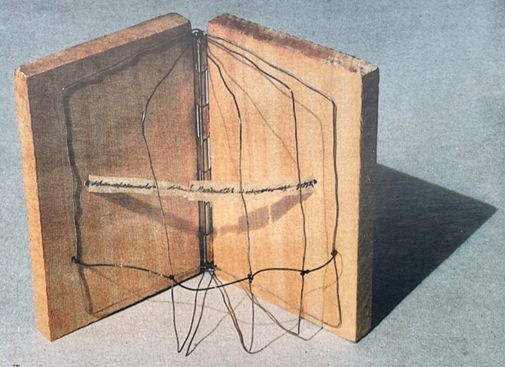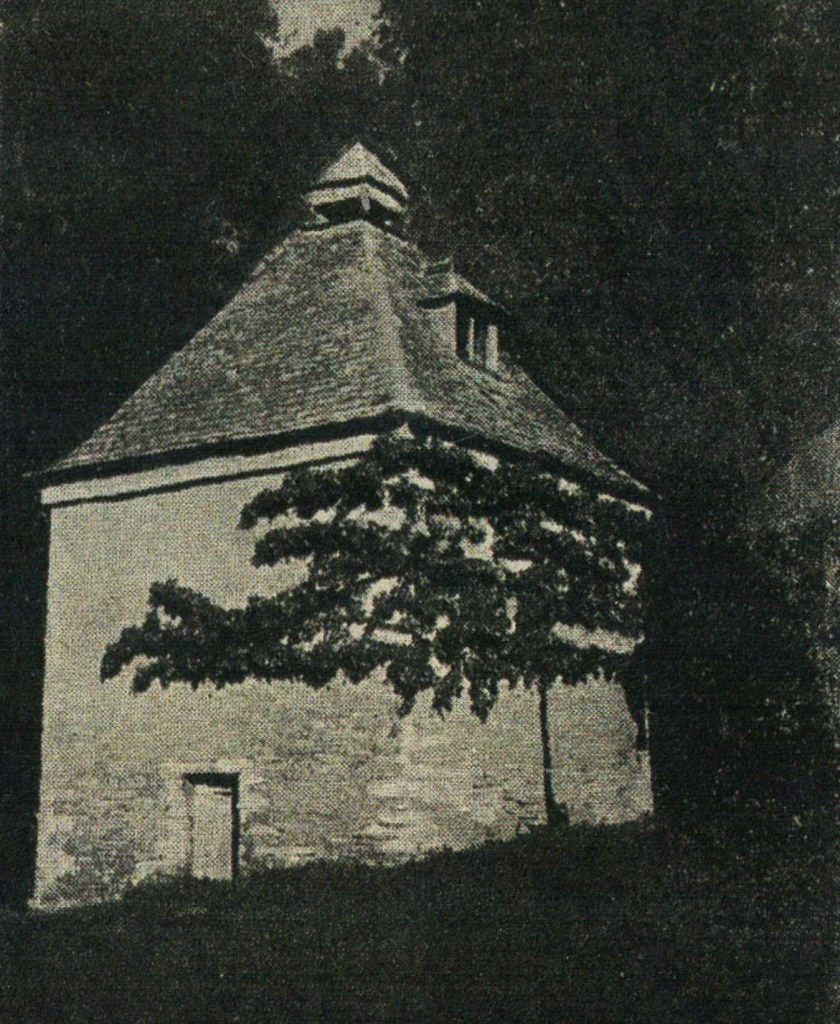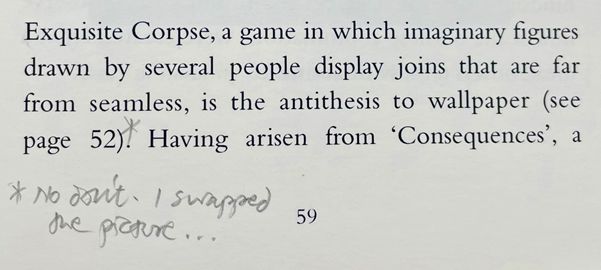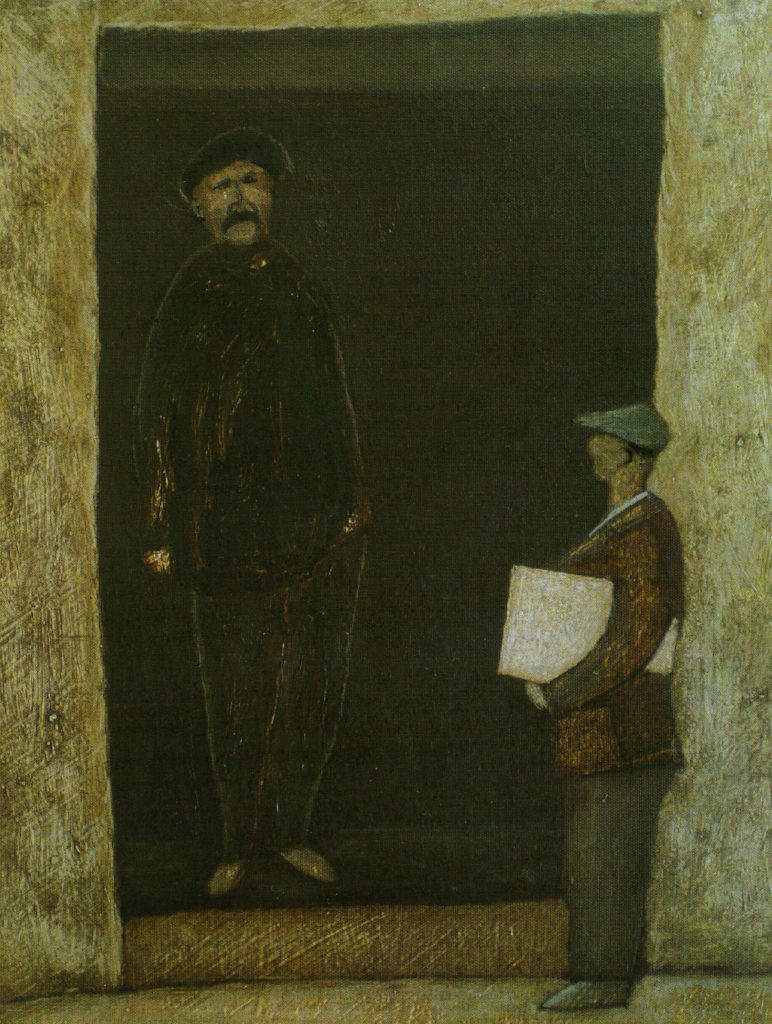This review covers Von Ribbontrop in St. Ives, The Daughters of Radon, The Only Non-slip Dodo Mat in the World, Bifurcated Thought, The Musings of Creatures in a Barren Land. Read it here.
One of the many remarkable things about Andrew Lanyon’s series of books on accessing the imagination is how perfectly their form and content combine. When, 10 years ago, I overheard someone saying to someone else at a party ‘Andrew Lanyon is making books’, what sprang to mind was ‘artist’s books’, perhaps something like this:

That is, I imagined symbolic books, or reflections on the idea of the book, in which form is everything and text has nothing to say, but is the shortest distance between two points: the arrival rather than the journey. The reality of these books is very different. On the surface, they seem to function conventionally. Their pages are two-dimensional, they contain print, and their words and images lie flat on the page. But any appearance of conformity is deceptive. They are not simply about the imagination; they manifest its workings in a mischievously clever combination of tangible and intangible ways.
In the first of the series, Von Ribbentrop in St. Ives (2010), Andrew writes that ‘in order to think about the idea of metaphors, it helps to use metaphors to describe them’ (p. 60). Each of the books is precisely such a metaphor, developed to enable the exploration of the recurrent theme of movement. The idea they elaborate is that the imagination is both accessed through movement, and itself creates by means of movement: in these books, accessing the imagination and imaginative creation are effectively co-terminous. Each presents this principle through use of a different metaphor (or what – in other writers’ work – might be called conceits). In Von Ribbentrop, the threatened invasion of St. Ives in the Second World War becomes a way of thinking about the new forms of art that emerged there during the 1930s (and the other way around); in The Daughters of Radon (2011), the radioactive rocks under St. Ives are brought into collision with a fairground sideshow as joint imaginative metaphors. These juxtapositions, or rather fusions, border on the unthinkable; there are moments in Von Ribbentrop, in particular, that prompt the response ‘but you cannot put these things together’ – except, of course, that you can. They are designed to provoke an almost frantic movement in the reader’s mind: a mental leap from one to the other, then back again, faster and faster, in an attempt to keep both subjects simultaneously in focus.
In later books, this movement itself becomes the subject. In The Only Non-Slip Dodo Mat in the World (2013), the writer and explorer Fortescue takes up lodging in the heads of a series of public statues, finding that movement between them is essential to his creative process. In Bifurcated Thought (2013), an entire house springs into being from the blowing of an imaginary wind, beginning as a small four-square structure like a dovecote and developing so rapidly in a great many different directions that ‘by the time wind bursts into an attic bedroom, the place is teetering on the verge of opening to the public’ (p. 8). In The Musings of Creatures Imagined in a Barren Land (2016), the entire action is set in a moving coach. Each of these central conceits is at once an image of the imagination and the stuff that the imagination acts upon, taking on an existence and an agency of its own. Perhaps the most striking example of this is the way that Rowley Hall appears in almost all these books. The elusive residence of the Rowleys, it was first introduced in an earlier book, In Search of Rowley Hall (n.d.), which technically isn’t part of the sequence about accessing the imagination, but which implies the ideas the sequence explores as a near-invisible source of a river somewhere in an inland field behind a pub might imply sea-shouldering whales. And just as that book has a continued physical existence, so too Rowley Hall reappears in book after book as a reference point – a local habitation and a name for the restless imagination.
As this suggests, the kind of imagination that is accessed in these books is an exceptionally thingy one; although it is accessed through movement, and is itself a form of movement, such movement is most in evidence when it comes into collision with physical objects. This is manifest not just in what the books ‘say’, but also in their layout, especially the way images are woven seamlessly into the text. In Bifurcated Thought, for example, the progress of a wind-driven thought is interrupted by an obstacle in its path:

The image functions as an obstacle for the reader too, but the text beneath continues the narrative, embodying the power of the wind that sweeps all before it; despite taking the form of a caption, which conventionally would be separate from the main body of the text, it is gathered up into it in such a way that the layout of the page mirrors the process of transformation of which the text speaks. Similarly, in Von Ribbentrop, a caption introduces a sequence of images that symbolically represent the impact of changing fashions in art on the fabric of the world:

The underlying conceit is the one that animates the entire book: that art disrupts and destroys the known world as fundamentally as war, and the way it is expressed encapsulates that disregard for boundaries. And here too, the format of the page effects an equivalent disruption. It isn’t just that the caption introduces a sequence of images that require to be read as if they were text, but also that the two together are presented as an endnote; just as text and image work collaboratively, rather than hierarchically, so too the endnotes present alternative narratives rather than supplementary information. As discursive and as fully illustrated as the ‘main’ text, they too juxtapose memories of actual bombing raids and events from the historical Von Ribbentrop’s visit to the town with combined visual and verbal explorations of the explosive effects of Naum Gabo’s and Ben Nicholson’s art practice. Both text and endnotes provide glimpses of some of the raw material that went into the making of the book, as well as of its transformation; both simultaneously make visible how history serves as footnote to acts of the imagination, and reveal its occasional intransigence. Far from being supplementary, the endnotes demand to be read alongside the text – and, since this is physically impossible, the movement of turning the pages back and forth in an attempt to take in two parallel and double-voiced narratives simultaneously makes the reader startlingly aware of how this emblematises an equivalent movement in the mind. And of how, when hand and eye falter, and logical order fails, the imagination leaps into the multiple breaches.
All of this is a multi-media form of the wit that also manifests in off-the-cuff associative wordplay and punning, as when Fortescue writes some short stories while lodged in a statue of Kipling, ‘But these were ‘just so so’ (p. 27). It appears, too, in the way several images occur in more than one book, as if a single reinvention weren’t enough – and sometimes the text struggles to keep up with the visual play embedded within it as when, in The Daughters of Radon, a description of the game Exquisite Corpse as ‘the antithesis to wallpaper’ is followed by the instruction ‘(see page 52)’ – to which is added a pencilled asterisk and the handwritten note:

Other images not only reveal the usefulness of the real as a starting-point for the imagination (as the historical facts in Von Ribbentrop do), but also uncannily suggest that Andrew’s imagination was at work in the streets of St. Ives a decade or more before he was born. In particular, in a photograph of Ben Nicholson standing at Alfred Wallis’s door, the large and startlingly white sketchbook under his arm appears to have been placed on purpose to provide tonal and psychological contrast: bright, abstract modernist geometries juxtaposed with the brooding lived experience of Back Road West.

It looks exactly like an Andrew Lanyon painting, but isn’t – until, 15 pages later, it is.

Including the photograph as well as the reworking of it not only shows life imitating art imitating life, but enables both physical, page-turning and imaginative movement between the two. The effect is comparable to that which Andrew describes in The Only Non Slip Dodo Mat, when he remembered, some time after writing Fortescue’s adventures, that:
There was a real Mr Fortescue, who had been an artist in St. Ives. I even had a glass negative of him tending bees. Having already written about such a character who summons his thoughts and gives them the freedom of his head, it was a surprise to see him with thoughts buzzing all over him. Only later did it occur to me that the whole imagination might be outside. (p. 82)

The play between the real and the imaginary images of Nicholson causes readers, too, to question the boundaries between material and immaterial, real and imaginary, and so to participate in the process of reinvention.
All of this means that reading these books is a delightfully disconcerting experience – and so too does the way they are shot through with what seem like flickering sideways glances to other texts. The chinked-open wardrobe on the first page of Von Ribbentrop calls to mind not just C. S. Lewis, but Gaston Bachelard’s theory of the imagination, which (he suggests) can be housed not just in formal architectural structures, but in lesser enclosed spaces, such as nests, shells, chests-of-drawers – and wardrobes. The barren landscape through which Rabelais and Cervantes journey in The Musings of Creatures invites memories of other barren landscapes that stand, loosely, for the forces that oppose the imagination: the desert in which the poet-narrator of Chaucer’s House of Fame finds himself when he decides to stop basing his writing on pre-existing sources, for example, and the wilderness traversed by Child Roland in the radio play by Louis MacNeice, or the empty beachscapes that surround Elizabeth Bishop’s houses of the imagination in ‘The Sea & Its Shore’ and ‘The End of March’. The disruptive experience of negotiating between text and endnotes in Von Ribbentrop and The Daughters of Radon just as disruptively recalls Spenser’s Shepheardes Calendar. Laurence Sterne is invoked directly in Bifurcated Thought, in the guise of a thought that ‘formed a shape in smoke, a flourish like the one described in the air with a cane in Tristram Shandy’ (p. 10), but in addition, his alter ego Yorick’s excursions in France in A Sentimental Journey seem to foreshadow the coach trip taken in The Musings of Creatures: it, too, is a mental as much as a physical excursion, where the movement of the mind (and, in Yorick’s case, the emotions) has a tangible impact on events in the outside world.
Perhaps most disconcertingly, the theory underpinning these books seems to be in a direct line of descent from medieval theories of creativity. In The Only Non Slip Dodo Mat, the possibility is raised that:
If the deterioration of both imagination and memory is linked, perhaps only material stored in the memory is accessed, nothing at all ever plucked out of thin air. ‘A good imagination’ may only be the ability to successfully access the memory store. (p. 4)
Both in conception and in the specific terms that are used, this quite startlingly echoes what Mary Carruthers has uncovered about the way that, in the medieval period, memory served the function that we now think of as belonging to the imagination: it was considered to be the source of invention. A key part of this theory is the way it allowed the memory to be envisaged as a store: a series of pigeonholes, a chest, or even an architectural structure, all designed to order the contents of the memory so that they could be easily retrieved and reworked into new material. And because, in the contemporary understanding of the structure of the mind, it was envisaged as made up of interconnected chambers, through which thoughts and perceptions travelled before finally taking up lodging in the memory chamber towards the rear of the head, the memory itself was frequently envisaged as an equivalent store.When Fortescue takes up residence in the heads of a series of statues, he becomes the very embodiment of this theory; moving between the eye sockets that give him glimpses of the outside world and the private chambers – or mental storehouse – at the back of the mind, and drawing on both in his writings, he becomes, as he observes himself, ‘a travelling thought’ (p. 33). Simultaneously a figure who is himself accessing the imagination, and a figure of the accessing process, he gives tangible representation to Aristotle’s observation that ‘the mind never thinks without a mental image’ – even when that image is an image of the mind.
Clearly, at least some and probably all of these parallels are purely chance perceptions: a series of Exquisite Corpses animated by juxtaposition of Andrew’s writing with what happen to be the contents of my own mind. But that is rather the point: while specific glimpses of likeness and unlikeness will vary from reader to reader, it is the process of discovery (or movement) between Andrew’s work and its ‘precedents’ that matters: it’s that process that enables each reader to experience (and embody) the idea of imagination as movement that these books explore. In this way, the comparative activity provoked by reading nicely replicates the experience of visiting the exhibitions, at Falmouth Art Gallery, of artefacts that in the books are represented by photographs. Moving from one to another, each visitor’s physical progress served as the means of making connections. And although there were suggestions as to the intended sequence of the exhibits, in practice of course people meandered, reversed, looping about in no fixed order. In doing so, they came to represent precisely the kind of reading fostered by these books, whose texts are so very far from proceeding in a straight line. Although a first glance might suggest that they function in good codex fashion, beginning at a given point and leading line by line to the end, in practice they comprehensively resist ideas of order. If they could be summed up in a single image, it would not be the ‘shortcut for text’, but one from The Daughters of Radon:
